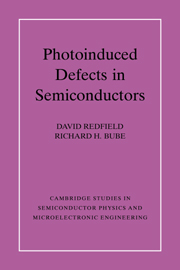Book contents
- Frontmatter
- Contents
- Preface
- 1 Introduction: Metastable Defects
- 2 III–V Compounds: DX and EL2 Centers
- 3 Other Crystalline Materials
- 4 Hydrogenated Amorphous Silicon: Properties of Defects
- 5 Hydrogenated Amorphous Silicon: Photoinduced Defect Kinetics and Processes
- 6 Other Amorphous Semiconductors
- 7 Photoinduced Defects in Devices
- References
- Index
1 - Introduction: Metastable Defects
Published online by Cambridge University Press: 15 December 2009
- Frontmatter
- Contents
- Preface
- 1 Introduction: Metastable Defects
- 2 III–V Compounds: DX and EL2 Centers
- 3 Other Crystalline Materials
- 4 Hydrogenated Amorphous Silicon: Properties of Defects
- 5 Hydrogenated Amorphous Silicon: Photoinduced Defect Kinetics and Processes
- 6 Other Amorphous Semiconductors
- 7 Photoinduced Defects in Devices
- References
- Index
Summary
Types of Defects
This discussion of defects in semiconductors deals with those having significant photoelectronic interactions. The word defect is used here as a shorthand for “imperfection.” It may therefore include any departure from the ideal periodic lattice of a crystal or, in the case of amorphous materials, any departure from an ideal continuous random network. These defects may take a variety of forms:
native point defects, such as isolated vacancies, interstitials, or antisite atoms of the host crystal;
point defects associated with the presence of isolated impurity atoms, in either substitutional or interstitial positions;
defect complexes formed by the spatial correlations between different point defects, such as donor–acceptor or impurity–vacancy pairs;
line defects, such as dislocations;
defects associated with grain boundaries in a polycrystalline material; and
defects associated with the existence of a surface or interface.
In keeping with the thrust of this book, some defects (e.g., phonons, dislocations, and interfaces or surfaces) are not treated independently.
General Effects of Defects on Electronic Properties
Any of the above defects can play a variety of electronically active roles that affect the electrical and optical properties of a semiconductor. Some of the traditionally accepted roles can be summarized as follows.
Donor or Acceptor Fundamentally, a donor is a defect that is neutral when electron-occupied, or positive when unoccupied; an acceptor is a defect that is negative when electron-occupied, or neutral when unoccupied.
- Type
- Chapter
- Information
- Photo-induced Defects in Semiconductors , pp. 1 - 23Publisher: Cambridge University PressPrint publication year: 1996



